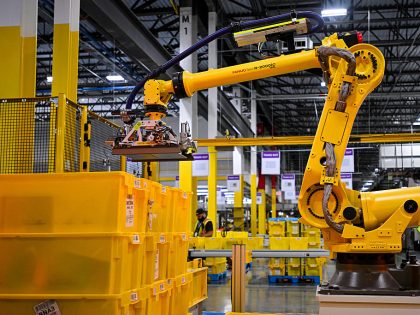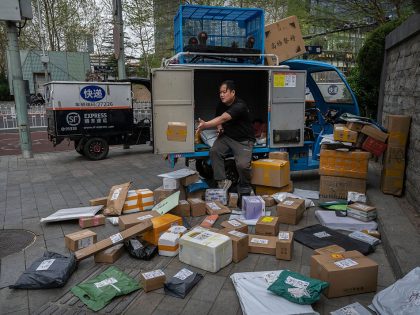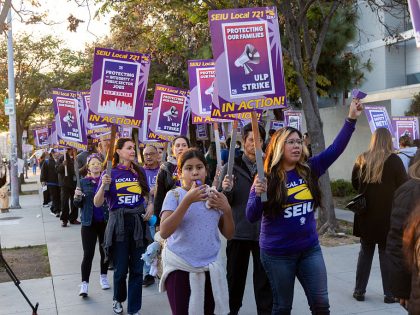
A Sober Look at Amazon’s Automation Drive
As Amazon rolls out its millionth robot on the warehouse floor, it is important to recognize that the company is not any closer to ridding itself of the burden of human labor. Amazon can still be unionized.
Page 1 of 4Next
Benjamin Y. Fong is associate director of the Center for Work and Democracy at Arizona State University. He has a Substack focusing on labor and logistics called On the Seams.

As Amazon rolls out its millionth robot on the warehouse floor, it is important to recognize that the company is not any closer to ridding itself of the burden of human labor. Amazon can still be unionized.

The recent round of Amazon corporate layoffs isn’t a sign of an imminent AI apocalypse. It’s an expression of the company’s brutal corporate culture, enabled by its use of the H-1B visa program.

The Tim Dillon Show is disorienting and disturbing. It also has a massive audience, to whom it reflects back the disorientation and disturbance of contemporary society in pseudo-personalized form.

Will Amazon disrupt groceries? How did Walmart take over food sales? Is Zohran Mamdani’s public grocery plan too small? Why is the market increasingly polarized between Erewhons and dollar stores? An ex–Whole Foods vice president gives us an industry tour.

Hu Anyan’s I Deliver Parcels in Beijing describes life working in China’s logistics and service trades. Anyan’s account reveals differences in context between Chinese and US workers that indicate the difficulty of international working-class solidarity.

Union approval is at historic highs, yet density keeps falling. The problem isn’t messaging but the lack of strategy that can turn popularity into power.

The labor movement improves lives for all kinds of workers, and the two largest National Labor Relations Board elections of the month of May were at two very different workplaces: the School of Visual Arts in New York City, and Dold Foods in Wichita, Kansas.

Organizing logistics behemoths like Amazon and Walmart will require the labor movement to figure out how to disrupt the flow of goods across the supply chain rather than simply organizing individual workplaces — and that requires a major rethinking of organizing strategy.

California boasts some of the most expensive cities in the country. Union organizing can help workers afford to live in those cities.

Decades of precedent, from RICO to asset forfeiture to “good faith” exceptions, have normalized warrantless search and gutted the Fourth Amendment. Hasan Piker’s detainment is the latest proof that constitutional rights are now largely a legal fiction.

In a slow month for large-unit elections, the United Steelworkers won a key victory at JSW Steel, which manufactures components for offshore wind turbines. Despite their green, ethical self-portrayal, the union says JSW fought them hard.

In the 1960s, psychedelics seemed to promise social progress. Today their proponents are all about self-optimization under capitalism.

In his new book, labor scholar Eric Blanc offers illuminating case studies of recent union victories. But it’s not clear that “worker-to-worker unionism” amounts to a widely applicable “emergent model” of unionism that can save the labor movement.

The largest NLRB union election win in February was at the primary care group Optum Care, a subsidiary of UnitedHealthcare. The vertical integration of health care has brought frustrating consequences for health workers, who are now organizing in response.

SEIU’s Committee of Interns and Residents won six NLRB elections in January 2025 involving 250 or more people. This string of victories has become somewhat commonplace for a rapidly growing union.

With the National Labor Relations Act now in the crosshairs of the Right, organized labor needs to confront an uncomfortable truth: even at its best, this framework has severe limitations. It’s time to explore alternatives.

In response to a successful unionization effort at a warehouse in Quebec, Amazon is shuttering its operations in the entire province. Its punitive behavior demonstrates that traditional organizing methods won’t work on the corporate behemoth.

During peak season, when Amazon’s holiday rush hits maximum velocity, the company’s finely tuned machine becomes surprisingly fragile. For workers seeking to organize, the high-stakes holiday months may be their strongest opportunity to exert leverage.

The recent longshore workers’ strike provoked pearl-clutching in the media about runaway salaries. But the notion of six-figure pay for blue-collar workers becomes less scandalous when we compare worker pay and purchasing power today to those in 1960.

When East and Gulf Coast longshoremen went on strike last week, their employers claimed to be unable to afford their wage demands. In truth, the shipping industry has seen unparalleled profits in recent years. The strike made them change their tune.